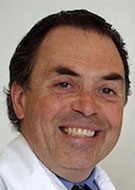Career Trajectory of Academic Teleradiologists Can Be Affected by Lack of Onsite Presence
Some institutions require research and onsite teaching



This is part two of a two-part series on the career trajectory of teleradiologists. Read part one.
What once was unimaginable—radiologists reading scans full-time from home—is now a common practice. At-home workstations installed during the COVID pandemic spawned new possibilities for teleradiology in both private practice and academic radiology. In this new era of teleradiology, the benefits are clear: health care institutions can efficiently access sub-specialties and 24/7 coverage, while the teleradiologist gains flexibility, autonomy, and work-life balance.
What is unclear, however, is if and how working remotely—especially in a full-time capacity—affects a radiologist’s career path.
“Everybody in our institution is allowed to read from home a couple of days a week,” said Michael Recht, MD, professor and chair, Department of Radiology at NYU Grossman School of Medicine. “We also have full-time remote faculty members who live across the country. They are equally important and valued in our academic department as our onsite faculty but have different responsibilities and career paths. In our department, research and teaching expectations are reserved for the onsite faculty while remote faculty have primarily clinical and administrative responsibilities.”
Dr. Recht said he’s aware of other institutions where fully remote radiologists can teach and have research responsibilities.
“I think the jury’s still out on how that’s going to work,” he said.
Preserving An Academic Environment While Addressing Wellness Benefits
NYU’s radiology department includes approximately 215 clinicians working either full-time onsite or on a hybrid schedule. These faculty can be promoted based on clinical, research, teaching or administrative functions, such as quality or operations.
NYU’s over 60 fully remote radiologists are fellowship-trained in every subspecialty other than interventional radiology. “Our evening and overnight ED section is almost entirely composed of remote staff and our section head works remotely,” he said.
“Incorporating remote opportunities for radiologists has been an important component of maintaining the correct staffing levels for our department and preserving the work-life balance for all of our faculty,” Dr. Recht said. “It allows us to attract excellent radiologists who don't want to live in New York or work in corporate medicine but want to be part of an academic department with access to all of the advantages of an academic department, such as state-of-the-art equipment and advanced imaging protocols and workflow.”
“Having a radiology career and climbing the academic ladder requires being onsite and participating in academic and research activities. If you aren't seeing people daily, you tend to be left out of fruitful exchanges with colleagues and peers.”
– OSMAN RATIB, MD, PhD

“I think that radiologists have different phenotypes,” Dr. Recht said. “We don’t have to be clones of one another. We should accept that different people have different interests. If we provide them the ability to do what they're passionate about, we believe that promotes wellness and increased engagement.”
“A faculty member who doesn’t want to teach or write papers can definitely progress and be promoted in their career, but it will take a different trajectory,” he said. “Their criteria for promotion is different than that of onsite faculty as it is based on their clinical, administrative and leadership performance.”
Dr. Recht said he would never advocate for a predominantly remote department.
“We need a critical mass of people to be on site to do all the functions that need to happen onsite,” he said. “Having the right number and proportion of people on site has allowed us to maintain visibility and integration with our referring physician colleagues and provide the optimal teaching environment for our medical students, residents and fellows.”
Remote Positions Can Benefit Personal Needs, Challenge Trainees
Osman Ratib, MD, PhD, former professor and department chair at Geneva University Hospitals in Switzerland, believes fully remote teleradiology positions are best suited for parents who want to work part-time while raising a family and senior staff who are transitioning into retirement. Hybrid activity combining part-time onsite and remote teleradiology work is probably the best combination, in his opinion.
“Having a radiology career and climbing the academic ladder requires being onsite and participating in academic and research activities,” Dr. Ratib said. “If you aren't seeing people daily, you tend to be left out of fruitful exchanges with colleagues and peers.”
Patrick Nicholson, MD, agrees. He said it is possible that promotion committees can have a bias toward radiologists who are more visible. He said there’s also a disconnect between work done onsite versus remotely.
“Simply focusing on Key Performance Indicators (KPIs) is a mistake,” said Dr. Nicholson, consultant neurointerventional radiologist at Beaumont Hospital in Dublin, Ireland. “You can have one person at home and one onsite, each reading 20 MRIs. However, at some centers, the person onsite may be doing additional work, such as answering questions from radiographers and conferring with clinicians. There may be a hidden body of work that’s not captured in reporting metrics.”
Dr. Nicholson expressed concern that these crucial extra tasks could breed some discontent among onsite staff who can’t read as efficiently as their remote counterparts, in settings where the work responsibilities are differentiated. He’s also concerned about residents, fellows and junior staff who train or work remotely.
“I know of major fellowship programs where diagnostic imaging fellows never meet in person, it is all online,” Dr. Nicholson said. “I think that type of interaction is fine for senior staff, but there’s a significant hidden cost to this type of training for fellows and junior staff. A lot of training is lost without everyday interactions with clinicians. There are a lot of curricula embedded in the organization’s culture. Junior staff that work almost exclusively from home don’t know what they’re missing.”
Although he believes the hybrid work model is here to stay, he cautioned about the effect it will have on the radiology profession. “I worry that we’re taking a step backward as a specialty,” he said, “if we allow ourselves to completely report from home and lose visibility as clinical partners.”
For More Information
Read previous RSNA News stories on radiology careers: